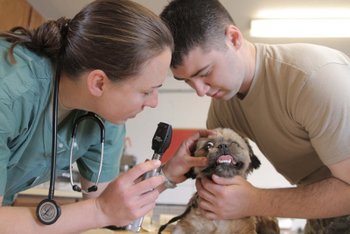
Just like people, blindness or an otherwise significant reduction in vision is a relatively common occurrence in our canine friends. Whether your puppy loses his sight in bright light or your old faithful companion’s eyes are looking a little "cloudy", the profound impact it can have on the life of both pet and owner, makes preventing or treating eye disease a major concern for veterinarians.
Though there are hundreds of possible biological processes responsible for blindness, these processes can be grouped into two major categories: Non-genetic (acquired disease) and genetically inherited disease caused by mutations in a dog’s DNA (the genetic material found in all cells). Though mutations in DNA are present at birth, disease can present in a variable timeframe from puppy to older dog, depending on the specific mutation present.
Though not all eye diseases have an inflammatory component to them, some of the most commonly acquired, non-genetic eye diseases involve chronic inflammation of the eye’s internal and external structures. External chronic eye inflammation gradually damages the structure of the cornea and can eventually lead to difficulty seeing. Most of the cases involve physiological abnormalities (i.e. eyelashes rubbing on the eye) or trauma resulting in changes such as cloudiness (scarring) or pigmentation of the cornea. Thus, preventing focused light from reaching the deeper structures of the eyes responsible for transmission of the signal to the brain. These dogs may not be fully blind, but can lack high visual acuity necessary for focusing on objects.
Inflammation of the internal structures of the eye can be even more devastating and can have a much more significant number of causes. Some common causes of acquired internal eye inflammation include trauma, various viral, bacterial, or parasitic infections, and allergic disease. Chronic inflammation can lead to glaucoma (increased pressure within the eye), damage to the retina or optic nerve (that transmits visual signals to the brain), and cataracts (cloudiness of the lens in the eye). In some cases, the severity of disease can lead to complete blindness.
A number of genetic or inherited eye diseases are familiar to dog breeders today. Many breed clubs have taken steps to decrease the incidence of these diseases through mandatory eye exams with a board certified, veterinary ophthalmologist. If a disease with known genetic cause is found, breeding that particular dog would be discouraged in order to prevent passing on the disease to offspring. In recent years, advances in genetic testing have made it possible to identify specific mutations in DNA responsible for certain eye conditions. The beauty of DNA testing and the information gained from it, is that prevention of the disease is possible and usually predictable. Without DNA testing, it is difficult to predict breeding outcomes. The reason for this is that many disorders are inherited in a "recessive" manner. For animals that "carry" a single mutated copy of a gene (all dogs receive one copy of a gene from their mother and one from their father), many do not express that particular gene in their physical appearance. Thus, one cannot look at the dog and predict if he is a carrier. If a carrier of a particular recessive mutation breeds with either another carrier or with a dog affected with that disease, about 25% of the puppies born would be expected to have the genetic condition. In addition, in some genetic diseases, even affected individuals do not show clinical signs of their disease until they are older, thus giving them ample time to breed and create multiple litters of puppies, all at risk of the same disease themselves. In either scenario, DNA testing of parents prior to breeding is the best choice to ensure healthy pups.
Though most conditions involving the eye are treatable in dogs and are not related to genetics, genetics can play a significant role in the development of eye disease in certain breeds. If looking to buy a new dog, do your homework about diseases frequently associated with that particular breed. If genetic diseases (eye related or otherwise) are known to exist in the breed, don’t hesitate to ask your breeder if any DNA testing had been done on the parents. Being that dog ownership is a significant financial and emotional investment; you might be able to avoid premature, unnecessary hardship that disease can bring to the relationship between you and your four-legged fur children! Due to possible secondary consequences of untreated issues, any sign of eye disease should be considered an acute concern that justifies a trip to your general veterinarian or board certified veterinary ophthalmologist.
This column is not intended as a replacement for personalized veterinary care. Please consult your veterinarian for medical advice regarding your pets.